Motorcycle.com

For years manufacturers have been locked in a dogfight to produce the best 600cc sportbike. Consumer demand for machines that are not only faster but better handling have forced them to constantly update and improve each model: These days, it is rare for a brand's flagship 600cc sportbike to go more than three years without a major redesign. While manufacturers have succeeded in producing remarkable motorcycles, the advances in technology have lead to astronomical prices, some soaring as high as $8,200. This places top-level 600s out of reach for many buyers, especially college students -- ever willing to finance their poverty-stricken, savings-depleted life away in hopes of a good job several years down the road, low payments are often the primary factor when buying a new bike. So where would you look for a quick middleweight sportbike at an affordable price? Not just inexpensive to purchase, mind you, but to own as well. We introduce you to the "Value 600" sportbike class -- Yamaha's FZR600 and Suzuki's Katana 600.
Suzuki's Katana has a simple instrument cluster consisting of large, easy-to-read speedo, tach and fuel gauges.
Yamaha's FZR shows its sportier edge with its tach and temp gauge separate from the speedo.Obviously, either value 600 will cost much less than top-level sporting machines, but how much bike are you getting for your budget buck? While both the FZR and Katana were competitive racers in the eighties, neither of them can hope to compete against modern 600s in any performance category. However, in the real world, lap times and stopwatches are unimportant -- but making it to class or the office on time is, and both machines will make capable and fun roadbikes. Old technology or not, riding either bike quickly is good enough to raise your pulse and get the blood flowing.
But how do these bikes compare? Which one offers the best performance value? Although both machines share the same inline-four engine configuration, when it comes to outright performance the FZR is a lap ahead of the Katana. The Yamaha has strong top-end power and pulls harder over a wider rpm range than the Suzuki. Even though dyno charts reveal the FZR has only a few more horsepower, it also weighs considerably less, obviously helping acceleration. Its combination of superior power, two-finger braking, light weight, narrow cockpit and nimble feel make it easy to jump on and go fast on the FZR. Our only concerns were a clunky transmission and quirky rear suspension. An aftermarket shock would greatly help the rear end's handling manners.
The Suzuki is a different story. Its extra weight, combined with poor turning characteristics (due in part to Suzuki's choice of Metzeler Laser front rubber), makes it intimidating for an inexperienced rider to go fast. The Katana often required extra countersteering input to complete a smooth arc when compared to the FZR. The little Kat would benefit from modifications aimed at quickening its heavy steering. Some trail could be taken out by pulling the fork tubes up in the clamps a few millimeters, which would reduce the effort required to turn the bike. Or a different tire combination with a more triangulated profile would help. Around town is where the Katana shines, as its thick seat, light clutch, high handlebars, and compliant suspension make for a pleasant ride.
Brakes on the FZR are excellent, providing great stopping power and feedback.
The Katana's brakes lack the FZR's smoothness and strength. While either bike will prove entertaining on a twisty road, fitting into your monetary restrictions is what the FZR600 and Katana do best. Manufacturer financing is available for both through their respective companies, with Suzuki offering the best deal of zero down and 14.9 percent financing toward a new 600 Katana. Yamaha, on the other hand, requires a minimum downpayment of 750 dollars and 18.00 percent financing to purchase the FZR600. On a 60-month program the Katana's payments will be $166.69/month versus $170.48 for the FZR. Note that buyers can save significant amounts by locating a dealership with leftover '96 models that differ only by paint scheme.
More About Valuebikes:
Full coverage insurance is mandatory when financing a new motorcycle in America, additional costs that should be factored into your decision. These 600s are relatively inexpensive to insure because motorcycle coverage is based on weight and displacement. A California State Farm Insurance agency quote for full coverage is $133.81 per month for either bike. Rates as low as $33.30 per month are available if your car policy is through State Farm and you have had a license for 10 years or more.
Obviously, financing and full-coverage insurance costs add considerably to the final bill for either bike. Buying an FZR with only 750 down would bring its total cost to a sky-high $10,978 with interest charges, almost a thousand dollars more than the 10,001 you'll pay for the Katana! This doesn't even include insurance, which could run as high as $8,028 for full coverage over a 60-month period. While not many of us are able to buy bikes outright, the more you can save towards the purchase price the better.
While a new rider who likes the flowing style of the Suzuki's fairing might pick the Katana, most people will opt for the FZR. Yamaha's budget 600 is a pleasure to ride, giving you all the confidence you need to go fast. Around town the FZR is narrow and light, making it easier to maneuver through traffic. Ergonomics are respectable for a sportbike, and adequate for 300 mile weekend travel plans.
Specifications
Manufacturer: SuzukiModel: 1997 GSX600FVPrice: ,099Engine: DOHC, 16-valve, inline four-cylinder, air-oil cooledBore and Stroke: 62.6mm x 48.7mmDisplacement: 599ccCarburetion: Four Mikuni 33mm CVTransmission: 6-speed, constant meshWheelbase: 56.3 in. (1430mm)Seat Height: 30.7 in. (780mm)Fuel Capacity: 4.8 gal, Calif. - 5.3 galClaimed Dry Weight: 438 lbs (199kg), Calif. - 440 lbs (200kg)Yamaha FZR600Manufacturer: YamahaModel: 1997 FZR600Price: ,499Engine: DOHC, 16-valve, inline four-cylinder, liquid-cooledBore and Stroke: 59mm by 54.8mmDisplacement: 599ccCarburetion: four 32mm Mikuni CVTransmission: 6-speedWheelbase: 56.1 in.Seat Height: 30.9 in.Fuel Capacity: naClaimed Dry Weight: 395 lbs
Riding Impressions:
1. Brent Plummer, Editor-in-Chief
A crisp winter day in Los Angeles dawned bright and sunny. Digging my leathers out of the closet, I brush off my kneepucks and head for the canyons: flick left, then right, -- this FZR turns really quickly and has moderate power to boot. Twist the throttle to the stop, descending along a gradual slope; now hard on the brakes and the 400-pound bike hauls down from speed with alacrity. 'For a bit over six grand,' I think to myself, 'it's not bad.'And then, just as the excitement of getting out to the canyons wears off, I have to make the 25-mile commute back to the MO offices. Five miles down the road, my wrists are killing me, and my mind wanders: 'Assuming most people interested in these bikes will finance their purchase, is this bike really worth a thousand dollars more than the Katana?'
The answer, at least for the older members of our staff -- we were clearly divided along age lines in this test, with the young guys outnumbering the old fuddie-duddies -- is a resounding "no."
I don't like riding down the road in pain anymore, so the Katana's nice seat, high bars and low pegs -- combined with Suzuki's attractive zero-down financing -- make it the clear winner in my book.
2. Shawn Higbee, Contributing Writer
Confidence is my number one priority whether I'm street riding or road racing. When a motorcycle is predictable and requires little effort to ride, that makes me feel in total control. The narrow cockpit, light weight, quick and easy steering input make the FZR600 feel like a toy. Within a few minutes of riding I felt confident in pushing the FZR to its limits. I could back the FZR into turns and spin the tire on the exit. The chassis is nimble with quick steering, and screams "flick me!"
I rode the FZR and Katana back-to-back a few times, and this solidified my choice of the FZR. I adapted to the Katana's quirks after riding it for a couple of weeks and was able to become content with the Suzuki as a street bike. But then I jumped back on the FZR, and thought, "oh-yeah!"
3. Billy Bartels, Graphics Editor
We've had these two bikes for awhile. I rode them both nonstop at the end of the summer, and grew to like them. I then hopped off them to go review a Kawasaki ZX-6 and a Buell Cyclone. When I jumped back on the Katana a month later, I thought someone had let the air out of the tires. It was just that heavy and unresponsive by comparison. To check the difference I rode the FZR the next day, and was pleasantly surprised by its light feel and reasonable comfort. I went back and forth to make sure I wasn't just a jaded squid at this point. Nope, I genuinely like the FZR and did not quite click with the Katana.
The Katana has low cost in its favor, and unfortunately it shows. Other than the handling, there's a buzz right at the bottom of the power band (not a great place for one), and the transmission occasionally popped out of gear on hard acceleration. By the way, it's heavy too. The FZR by no means is the clear winner however. The seat is useless if you're over 180 pounds, or carry a backpack (as I found out the hard way). The driveline lash is excessive, causing it to occasionally unload the suspension in a turn (not fun). Also the mirrors could be described as vestigial, as they offer you no more than a look at your sleeve. Other than those little quirks, a very capable little bike. Faster and better handling, in a well-put-together package that bridges the considerable price difference.
4. Gord Mounce, Associate Editor
While these two Value 600s are in the same category, they possess quite different personalities. The Katana is user friendly and makes a great streetbike. However, when the pace picks up its slow turning speed and extra weight limit the fun. Yamaha's FZR isn't as easy to hop on and feel immediately familiar with, nor is it as comfortable as the Katana. But when you get a few miles on the odometer the FZR's chassis starts to inspire confidence, you find yourself carving through corners at a pace that would be impossible on the Katana. To me, that's what owning a sportbike is all about. The FZR gets my vote. 5. Tom Fortune, Managing Editor Numbers are numbers. And in this comparison, those numbers equal dollars. Dollars I'd rather have in my pocket. Hey, the whole gist of this story is supposed to be which bike delivers the best performance value for the buck, right? And at zero $$ down plus a $400 lower purchase price to boot, the Katana's my choice.
For the money I'd save, I could live with the little Kat's shortcomings, which really weren't that bad. In fact, on a twisty back road I thought it handled pretty damn good, thank you. You wouldn't really notice any handling quirks at all unless you jumped from the Katana to the FZR, and then went back to the Katana. Only then did its high weight and slow steering seem wrong. And for taller riders like myself, the Suzuki was way more comfortable than the racer-boy ergos of the FZR. I'm not so sure we should be talking about which bike has more horsepower or can carve a corner quicker -- if you go to buy one of these, remember that the Katana is very user friendly, an important consideration for a beginning rider, and delivers the best bang for the budget buck.

Motorcycle.com presents an unrivaled combination of bike reviews and news written by industry experts
More by Motorcycle.com Staff








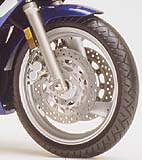












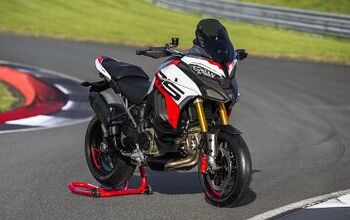
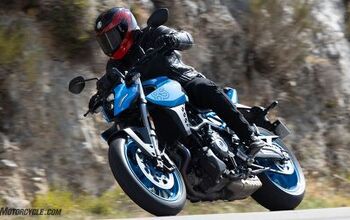
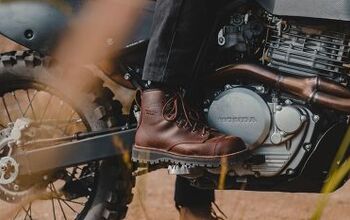
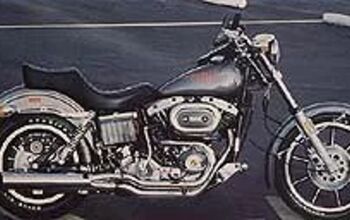













Comments
Join the conversation